Growing mushrooms, whether domestic or commercial, is a fascinating activity that allows enthusiasts to enjoy a wide variety of mushrooms, whether edible, medicinal…or magical! However, as with any form of agriculture, growing mushrooms is not without its challenges, and one of the most important problems that growers face is possible contaminations, usually caused by other fungi or bacteria.
As we say, these contaminations can come from various sources and can compromise the quality and safety of the mushrooms produced. In fact, any professional will recommend discarding any mushroom cake (not to mention the mushrooms themselves) that has any type of contamination. In today’s article, we are going to take a look at how you can prevent them, which are the most common, and what can be done in case you find traces of molds or bacteria in your mushroom cake.
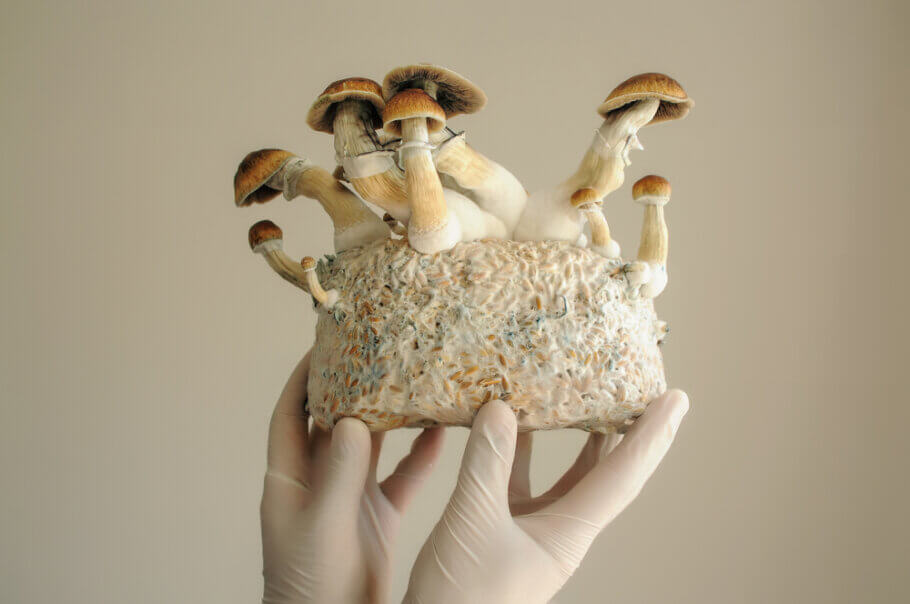
Contamination and mushroom cultivation
We know. Few things annoy a mushroom grower more than seeing how his cake shows strange colors and textures on its surface, something that can only mean one thing, that it is contaminated by some type of microorganism. Broadly speaking, these are the main types of contamination that can occur when growing mushrooms:
- Bacteria: Bacteria can colonize growing substrates and compete with fungi for nutrients. Additionally, some bacteria can produce toxic compounds that can harm mushrooms or make the mushrooms produced unsafe for human consumption. On many occasions, they appear as colored spots on the cake, which can range from pink to orange.
- Mold: Mold fungi can compete with cultivated fungi for substrate resources and produce toxins that can be harmful to human health. Mold can also ruin mushroom cakes by covering them with spores and growing in the right humidity and temperature conditions. They are usually the number one enemies of your crop.
- Yeasts: Yeasts can colonize culture substrates and compete with fungi for nutrients. They can also produce toxins that can affect the health of the mushrooms or the quality of the final product.
- Microbial contamination: This category includes a variety of microorganisms, such as fungi and protozoa, that can colonize growing substrates and negatively affect the growth and health of fungi. A classic example is a fungus widely used in cannabis cultivation that you may be familiar with, Trichoderma harzianum, which usually appears as greenish spots on the surface of the cake.
Growers must take preventive measures to avoid these contaminations, such as maintaining adequate hygiene, using quality substrates, and monitoring growing conditions daily. Only in this way can the production of mushrooms that are safe to consume and healthy be guaranteed. Often, 6 different vectors can bring contamination to your mushroom crop:
- The grower: your clothes, your hands, your hair, and even your breath can contain microorganisms or spores that contaminate your mushroom cake.
- Air: Likewise, air carries millions of spores and microorganisms, so try to keep your cakes away from air currents or environments that may be loaded with spores.
- The substrate: poor sterilization of the substrate or improper handling of it once sterilized can bring unwanted contamination.
- Tools: not sterilizing (or, at least, disinfecting) work tools is a good way to encourage the appearance of other fungi, yeasts, or bacteria.
- The inoculum: refers to the medium in which the spores (or liquid mycelium) are maintained before their inoculation into the substrate or culture medium. Again, as with the substrate, poor sterilization or manipulation of the inoculum can cause problems.
- Other mobile sources of contamination: We are talking about any organism that moves of its own volition and that can easily contaminate your crop, from insects or mites to your pet.
Prevention and hygiene, keys to avoid contamination
To prevent contamination in mushroom cakes, it is essential to implement proper hygiene practices and maintain a clean and controlled growing environment, something that both cake producers and cake growers must do. Some preventive measures include:
- Sterilization of the substrate: Before starting the culture, it is important to sterilize the substrate to eliminate any unwanted microorganisms that may compete with the fungi. This can be achieved through sterilization techniques such as pasteurization, the use of pressure cookers, or, ideally, the use of autoclaves. Furthermore, the spore syringe with which the spores or the liquid mycelium will be inoculated should have been previously sterilized.
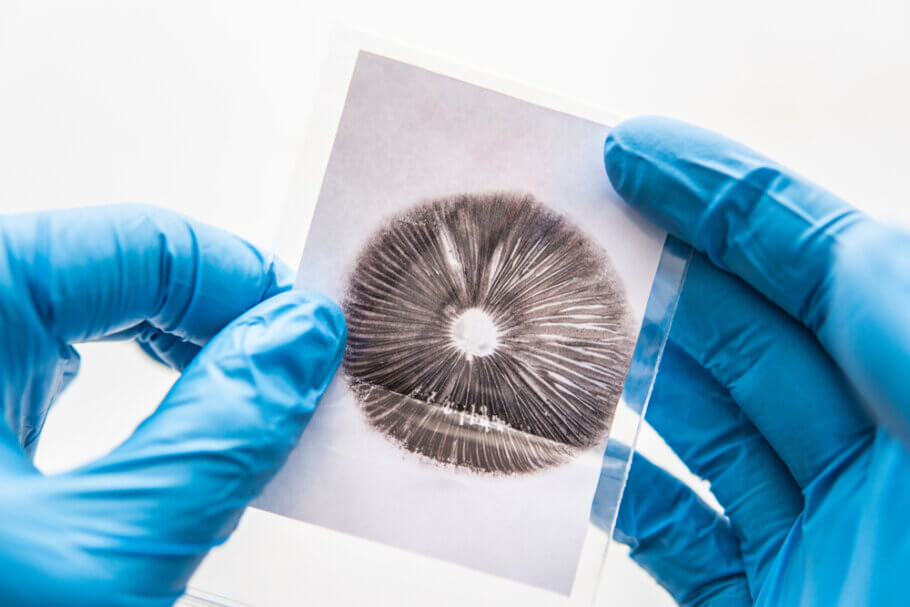
Spore prints and syringes of magic mushrooms
Today we are going to tell you how to prepare a spore syringe from prints or vials, a simple process that requires maximum hygiene to minimize the risk of contamination. In addition, we will present you the different options you have to reproduce the mycelium and get a copious harvest of mushrooms.
- Use of quality substrates: Using quality substrates free of contaminants is essential to avoid the introduction of pathogens into mushroom cakes. It is recommended to purchase reliable commercial substrates or carefully prepare them under controlled conditions. If you are going to use some type of grain, make sure it comes from organic farming, this way you will avoid possible traces of fungicides that prevent the correct development of the mycelium.
- Hygiene maintenance: It is important to maintain a clean and tidy growing environment. This includes disinfecting hands before handling mushroom cakes, disinfecting tools and equipment used in growing, and regularly cleaning the work area and growing facilities. Likewise, it is a good idea to place the cakes at a height, away from the ground, and ensure that the area where you have them is free of drafts. Wearing a mask while handling the cake can also be useful, as well as using laminar flow hoods if you can access them.
- Humidity and temperature control: Maintaining optimal humidity and temperature levels in the growing environment can help prevent the growth of unwanted microorganisms. It is important to monitor and adjust these parameters as necessary to create favorable conditions for fungal growth. Still, keep in mind that the ideal conditions for your mushrooms to develop usually coincide with those of many of the microorganisms that can contaminate your cake.
- Insulation and monitoring: Precisely for this last reason that we have seen, it is important to monitor the condition of the cake daily to evaluate its condition, both in terms of contamination and the degree of humidity (if it is cracked or very separated from the walls of the container, there is probably a lack of humidity). Separating contaminated mushroom cakes from healthy ones and closely monitoring any signs of contamination, such as mold or bad odors, can help prevent the spread of contamination throughout the crop. Try to keep your healthy cakes in another room, away from those you suspect may be contaminated.
By implementing these preventive practices in mushroom cultivation, you will be able to significantly reduce the risk of contamination in mushroom cakes and guarantee your goal, which is none other than a generous, safe, and healthy harvest.
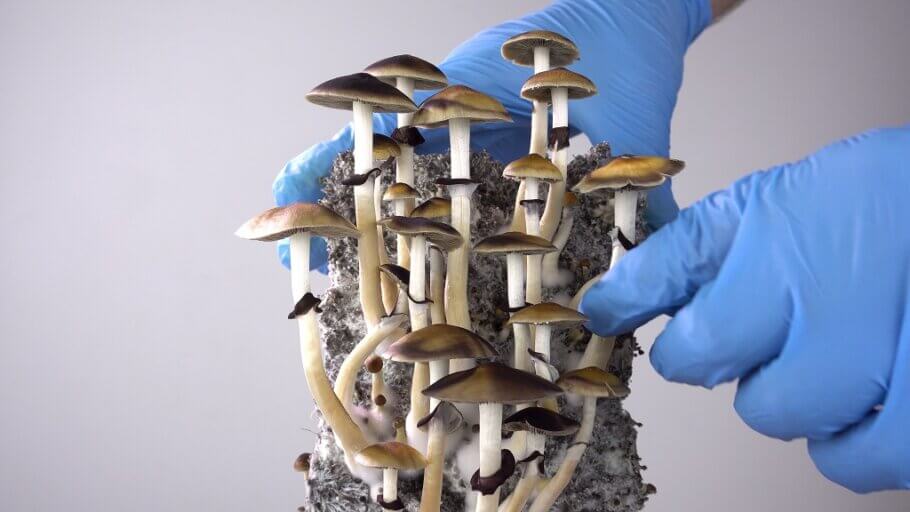
How to avoid contamination in mushroom cakes
Despite having followed our advice step by step, your cake may still end up contaminated for one reason or another. Don’t despair, it has happened to all of us; After all, it is difficult to keep under control microscopic organisms that can deposit on your cake any time it comes into contact with the air or even your breath. It may even be the case that your cake was already contaminated upon receipt, although the chances are lower if the cake has been inoculated under the correct conditions.
Normally, most contamination occurs during cultivation, after opening the cake container for the first time…the air can contain thousands of spores of other fungi, as well as bacteria and other microorganisms that can threaten the health of your cake! For this reason, we advise you to be especially careful when handling them: when starting the cultivation process, the ideal would be to leave the container on a previously disinfected surface, of course having also disinfected your hands (you can use nitrile or latex gloves and clean them with alcohol or some disinfectant gel). Close the doors and windows of the room and wait about 10 minutes for the air and the suspended particles it carries to settle.
Once this time has passed, you can proceed to open the container and start the cultivation process. Try to never touch the cake or breathe on it, and avoid drafts at all costs while handling it. As already mentioned, wearing a mask at this time will reduce the chances of contamination. Once you have finished the process of preparing the cake for the mushrooms to fruit, leave it in its final location and monitor its condition daily; Basically, you are looking for any type of stain on its surface that is not white, which is the color of magic mushroom mycelium.
Since your bcake can be contaminated by fungi such as Trichoderma, which are usually found naturally in many substrates or growing products, make sure to keep it away from other plants. Of course, growing mushrooms in the same room as growing cannabis is not the best idea, as beneficial microbial life such as fungi and bacteria are often used to enhance plant development, something that could easily result in contamination of your cake. So, be especially careful if you are also a cannabis grower and use these types of products, any trace of them on your hands or clothes can ruin your mushrooms! As we have already said, if you have a laminar flow hood, do not hesitate and carry out all operations against its sterilized airflow.
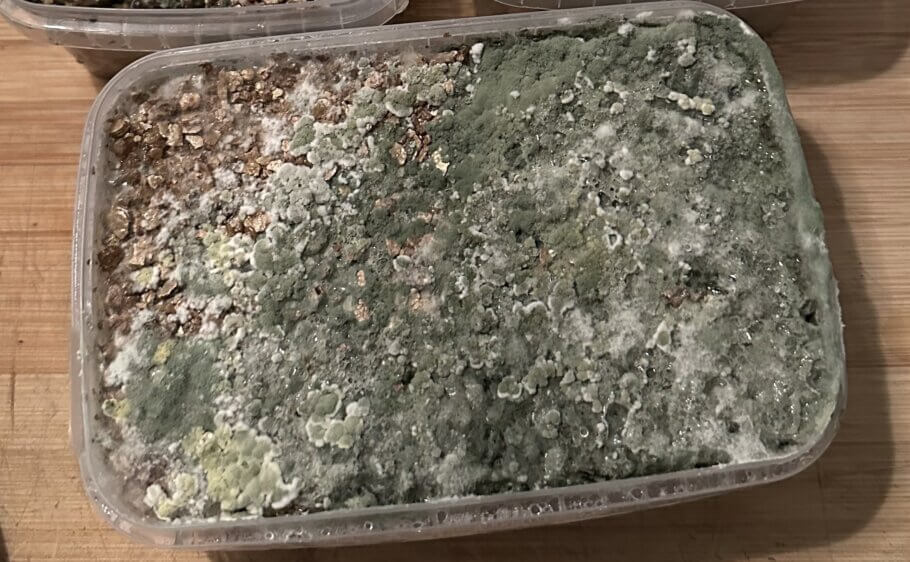
Contamination in mushroom cakes: what to do?
You have followed our advice to the letter but your cake still seems contaminated. These are things that happen, it is difficult to find veteran mushroom growers who have not had it happen to them at some point! Typically, it is recommended to dispose of cake immediately by placing it in the trash bin to keep it as far away from other healthy cakes as possible. However, it may be your only cake, so there is no risk of contaminating others, or the contamination may be in its early stages. We are not going to deceive you: in most cases, the mycelium of your mushrooms will “lose” against contamination and will gradually give way to the intruding fungus or bacteria, although if it is not serious it may give you time to harvest a few mushrooms before discarding it.
There are factors, such as too low temperatures or poor ventilation in the growing environment (which will lead to the formation of excess CO2), that can cause the mycelium of your mushrooms to not grow at the appropriate speed, which can lead to other microorganisms settle on the cake and try to colonize it. However, if your cake ends up showing signs of slight contamination, you still have several options to harvest at least the first batch or flush of mushrooms. Let’s see how:
- Put on your mask, disinfect your gloves, and disinfect a dessert spoon (ideally, you would sterilize it with a pressure cooker or autoclave). To disinfect you can use isopropyl alcohol.
- Very carefully, remove the part of the cake affected by contamination with the spoon. Avoid sudden movements that could further spread the intruder’s spores onto your cake. Once you finish the process, try to get rid of the affected parts as soon as possible by throwing them in the garbage container, away from the cake.
- Finally, cover the area where the contamination was with sea salt, a layer of 1-2mm will be enough. In this way, an attempt is made to inhibit the growth of spores that could have remained in the substrate. Leave the container with the cake back in its place and monitor its condition daily.
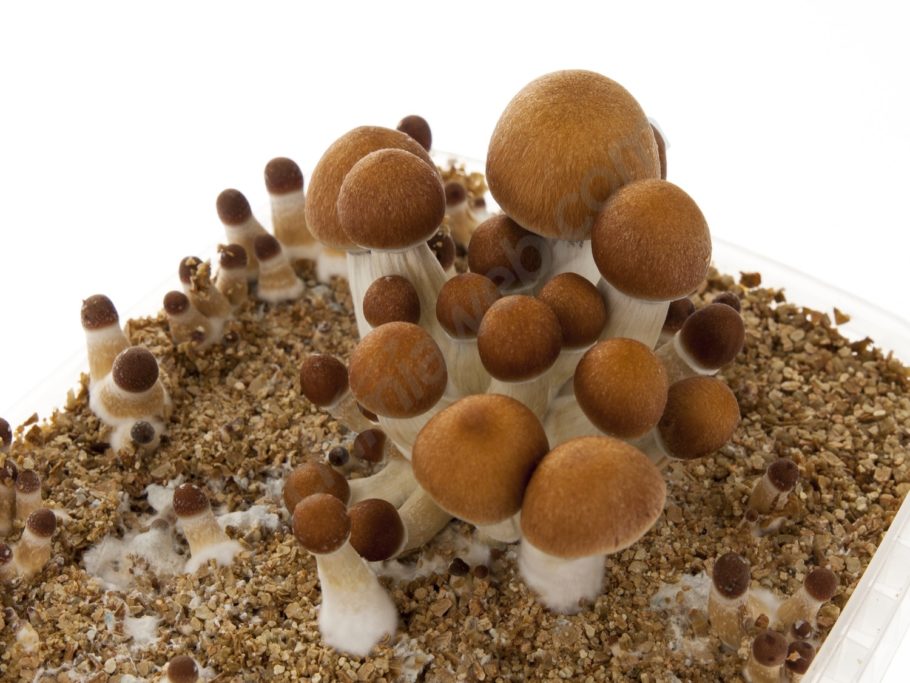
Magic mushrooms for beginners
Getting started in the world of magic mushrooms can be very confusing for the uninitiated, who usually don’t know the different strains or the correct dose to begin with. In this article, we clarify all your doubts, from the most suitable genetics to the right dose and the importance of the so-called set and setting.
Types of contamination in mushroom cakes
Although we fear that this information is more of a curiosity to identify the contamination itself rather than to help you combat it, here is a list of some of the types of contamination most commonly found when growing hallucinogenic, medicinal, or edible mushrooms:
- Green mold: This is almost certainly Trichoderma harzianum. Complicated to diagnose at first, because, in its first phases, it grows like a white fungus very similar to the mycelium that you are trying to fruit. As the infection progresses it turns green and can even grow on mushrooms.
- Blue Mold: This is usually Penicillium spp., of which hundreds of species can be found. As in the previous case, its growth is much faster than that of the mycelium, and it soon acquires a blue-green color. It spreads very easily, so the most prudent thing to do is to throw away any cake or inoculation jar with this type of stain. If you see blue stains on the cake, try rubbing them lightly with a Q-tip; If it appears stained, it is contamination.
- Black mold: it can grow on any substrate, and is usually associated with Aspergillus spp. , very dangerous for your health if you inhale its spores. As in the case of Penicillium (with which it can be confused), it is best to discard any infected culture medium.
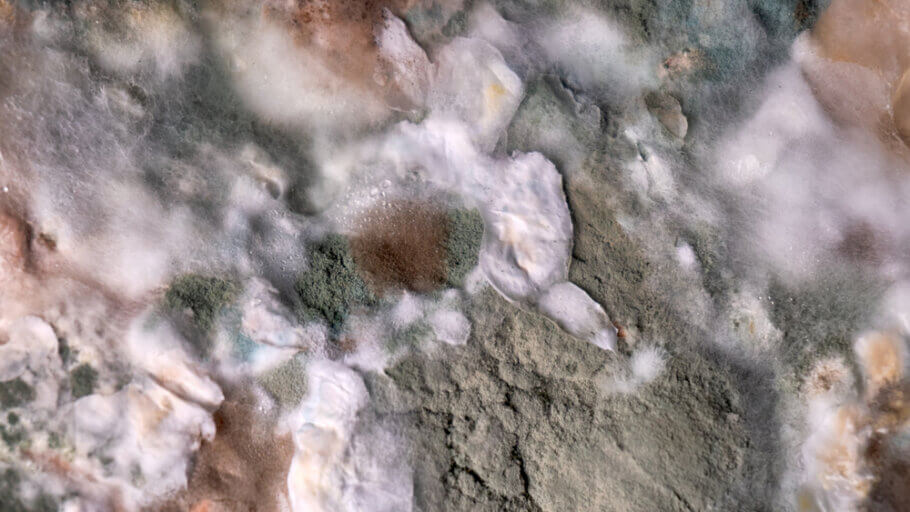
- Olive-green mold: often confused with Trichoderma, Chaetomium spp. develops as dark green spots on the substrate, although it is usually more present in composted growing media. It is especially dangerous for people with immune system problems.
- “Lipstick” mold: this is Geotrichum spp. , which usually grows as spots that turn white at first, then turn red, and then orange at the end of their cycle. It is one of the slowest growing and easiest to identify, so it does not usually cause serious problems if it is removed in time.
- Yellow spots: once your mushrooms have begun to develop, they can be infected by Pseudomonas spp., which develops as yellow or brown spots on the mushroom cap, usually on the edges. Typically, this is due to excess humidity or not enough fresh air.
From here we can only encourage you in case you have encountered any of these problems. However, keep in mind that although an infection can always happen when growing mushrooms, if you follow the advice in this post you will greatly reduce the chances of disaster, so we highly recommend that you do so!
Happy harvest!
References:
- The psilocybin mushroom bible, Virginia Haze, K. Mandrake
- Magic mushrooms growing guide, simple steps to bulk cultivation, Principium Quaesitor
- Major Fungal Contaminants of Mushrooms and Their Management, Ashish Ghimire, Krishna Raj Pandey, Yagya Raj Joshi, Sobita Subedi
The articles published by Alchimiaweb, S.L. are reserved for adult clients only. We would like to remind our customers that cannabis seeds are not listed in the European Community catalogue. They are products intended for genetic conservation and collecting, in no case for cultivation. In some countries it is strictly forbidden to germinate cannabis seeds, other than those authorised by the European Union. We recommend our customers not to infringe the law in any way, we are not responsible for their use.
Source link
#Contamination #magic #mushroom #cakes #prevent #Alchimia #Grow #Shop